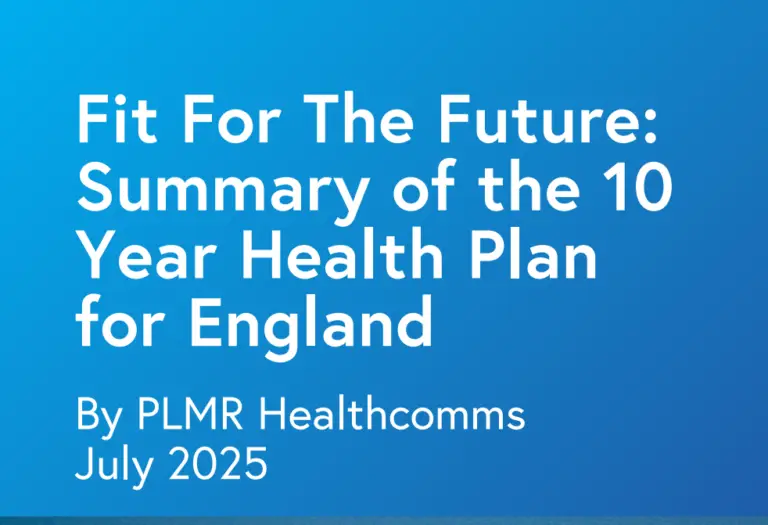In the press conference for the launch of the 10-Year Health Plan yesterday, journalist Chris Smith asked the Prime Minister “why will the 10-Year Health Plan succeed where so many others have failed before?”. This is the question that many in the sector have been asking themselves in recent months.
In the House of Commons chamber yesterday, Wes Streeting MP said, “no longer will NHS staff have to enter 7 passwords to log into their computers, or spend hours writing notes and entering data. Our plan will liberate frontline staff from the parts of the job that they hate”.
All things which other Secretaries of State have tried to achieve, and which all have subsequently failed to deliver consistently across the NHS. However, this is a bold and ambitious plan, which will mean significant reform to how care is delivered, received, administered, measured, and funded.
The fact that it has taken a year since the General Election for the Department of Health and Social Care (DHSC) to produce a strategy for the NHS is much-discussed, but the need for reform is urgent, and it is good that DHSC has consulted widely to make sure that this plan reflects the needs of patients, the NHS, and the financial situation in the UK.
Some of the key elements of the plan are bold and ambitious; and many of them – such as the expansion of the services available via the NHS App, the roll out of Neighbourhood Health Services, the push for prevention in tackling obesity through partnership with supermarkets and others – have been trailed well ahead of publication of the plan. But it is unclear how some of them can or will be delivered. Indeed, digital, data and tech run right through this plan, and will form a plank of reform for the next decade.
For example, the commitment to deliver a fully digitised health service by 2035 feels like the – yet undelivered – pledges to remove paper and fax machines from the NHS.
The single patient record would be an incredibly welcome step in joining up patient records. However, it needs to include primary and community sectors, particularly if the Government’s intention is for patients to flow across community care rather than access secondary care where possible.
Alongside the push for AI across the NHS, other big technology commitments will require change management support to ensure delivery. One welcome aspect of the plan will be the requirement that NHS bodies hold 3% of their budgets for delivering and implementing large scale projects and change management programmes.
It is unclear how funding flows impacted by patient feedback will work in practice, and it will be a big job for the Department to shape those proposals effectively to deter perverse incentives and gaming of the system. Further, the removal of deficit support funding whilst at the same time incentivising excellence could lead to a doom spiral for providers that are unable to improve services and balance their books.
However, it is important to remember that this is a 10-Year Plan. It is meant to bring cultural, practical, and meaningful change for the way the NHS delivers care and manages its finances. It is not going to take place overnight. In reality, cultural and embedded practices within the NHS are going to take time to unwind and rewire.
The public, Parliamentarians, and the wider sector – including industry – will be impatient for the delivery of change. Political challenges too – as evidenced by the challenges faced by the Government in Parliament this week – that will be echoing in the ears of Wes Streeting and the political team in DHSC. Failure to deliver on this plan, improve services for patients, and turn around a broken NHS, will be catastrophic for the Labour Party at the next election.
Now that the direction of travel has been set, it is vital that the Government begins to deliver on some of these changes. With so much uncertainty in the system – the shape, size and scope of ICSs, the future for NHS England, and how it will be subsumed into DHSC, and now the wider changes outlined in the 10-Year Health Plan – the Government will need to start to tell the sector how it plans to deliver this urgently. It is notable that the ‘Delivery’ chapter from the 10- Year Health Plan was removed before publication (as reported in the HSJ).
The launch of the Life Sciences Sector Plan, too, has been delayed, meaning a lack of detail and clarity on the future for regulation, adoption, and wider support for a key growth sector for the UK Government and economy.
There remain challenges, too, of how to repair the broken NHS without considering the role and future of the care sector – a plan for which has been pushed back to late in this Parliament.
But this ambitious plan for the future of the NHS contains many measures which patients, the NHS and industry will be rightly happy with and finally sets in place a direction of travel for reform, which the entire country will need to get behind to deliver.
Summary
Yesterday (Thursday 3rd July), the Government released its 10-Year Plan Health, a comprehensive plan that sets out the Government’s mission to build a health service fit for future.
The Plan sets out how the Government will reinvent the NHS through 3 core shifts:
- Hospital to Community
- Analogue to Digital
- Sickness to Prevention
If you have any questions or would like to set up a meeting to discuss further, please do contact your PLMR Healthcomms Account Team.
Download the PLMR Healthcomms Insights PDF here.
PLMR Healthcomms Insights Fit For The Future 10 Year Health Plan for England




